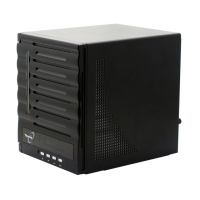Media Server
With the built-in Media Server capability, the N5500 provides media streaming
service to stand-alone networked home media adapters that support the UPnP AV
protocol or are Digital Living Network Alliance (DLNA) standard compliant.
To set up the Media Server, refer to
Chapter 4: System Network >Media Server.
Backup Server
Don’t leave precious data to chance. With advanced backup capabilities, you can
easily upload mission critical files to the N5500, and even automate your backup
tasks for true peace-of-mind.
To find out how to backup your files with the N5500, refer to
Chapter 4: Backup >Nsync.
Printer Server
With the N5500’s Printer Server, you can easily share an IPP printer with other PCs
connected to your network.
To set up the Printer Server, refer to
Chapter 4: Application Server>Printer Information.
Multiple RAID
N5500 supports multiple RAID volumes on one system. So, you can create RAID 0
for your non-critical data, and create RAID 5 for mission-critical data. Create the
RAID levels depending on your needs.
To configure RAID modes on the N5500, refer to
Chapter 4: Storage Management >RAID Information.
Dual Mode Support
N5500 is not only a file server, but it also supports iSCSI initiators. Your server can
access N5500 as a direct-attached-storage over the LAN or Internet. There is no
easier way to expand the capacity of your current application servers. All the
storage needs can be centrally managed and deployed. This brings ultimate
flexibility to users.
To set up an iSCSI volume, refer to
Chapter 4: Storage Management > Space Allocation > Allocating Space for
iSCSI Volume.
Superior Power Management
N5500 supports schedule power on/off. With this feature, administrator can set at
what time to turn on or off the system. This feature is a big plus for people who want
to conserve energy. Wake-On-LAN enables administrator to remotely turn on the
system without even leaving their own seat.
To schedule system on and off, refer to
Chapter 4: System Management>
10

